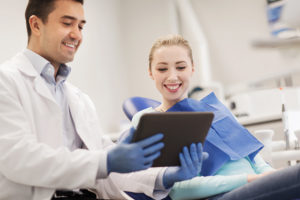The headlong rush toward artificial intelligence and a fully digital future likely means many jobs are in jeopardy. Should dentists be concerned? BY HOWARD STRASSLER, DMD
I LOVE TECH. My favorite things to read and podcasts to listen to concern the technology of today and tomorrow: the way we live, how we’ll likely access the products and services that are the lifeblood of the modern economy.
Chief among tech news of late is artificial intelligence. Robots, we’re told, will make some jobs—indeed, some entire professions—obsolete, and sooner than we might think. Are dentists in any kind of jeopardy? I don’t think so. In fact, as I see it the future is bright, with a welter of technological resources that will help us practice even better.
The twentieth-century dentist was very much an analog creature. Nuts and bolts, gears and valves: Much of what we did, and the equipment we used, was out in the open, visible to all. Radiographs processed by feeding film onto rollers in a variety of chemical solutions; photographs taken with slide or print film that we then had to mail to Kodak and wait for their return.
Today’s dentistry is suffused with digital images, of course, but it still entails a lot of touch and feel. In the brave new world of A.I., though, programming, big data and algorithms will have dental clinicians feeding information into a black box of sorts that will, we hope, spit out correct answers.
The headlong rush toward artificial intelligence and a fully digital future likely means many jobs are in jeopardy. Should dentists be concerned?
Artificial intelligence has captured our interest and imagination. To put it in baseball terms, though, the A.I. revolution is only in the top of the first inning. Ditto “machine learning” and “deep learning,” too. People use the terms interchangeably, but there are some subtle differences. Artificial intelligence, put plainly, is the challenge to create machines that exhibit human smarts. In 1950 the famed British computer scientist Alan Turing developed his eponymous test to gauge a machine’s ability to do just that. Machine learning is the means through which we develop artificial intelligence, and deep learning refers to the techniques for implementing machine learning, one of which is the development of artificial neural networks.
The future we desire, of course, is one in which we enable practical applications to improve the human condition. A.I. first captured attention when computers began beating humans at games: IBM’s Big Blue defeating chess masters, Watson topping the best Jeopardy! champions. Google DeepMind’s AlphaGo program has beaten the best human player of Go, the fiendishly complex board game.
Yet as unsettling as such outcomes can seem, they’re only rudimentary in the grand scheme. Even the best robots fall over and can’t get up. Much of what’s being showcased is simply those artificial neural networks that can make millions of complex statistical correlations with enormous data sets in seconds. That far outstrips what even the brightest humans can do—but the challenge for the computer is making a decision, a choice that is relevant, optimal and sustainable.
The big-data genie is not going back in the bottle. Do a cursory search online for shoes, and suddenly shoe ads follow you everywhere you go on the Web. The hullabaloo over how much Google, Amazon and especially Facebook know about us is of concern, surely, but for the most part we’re not talking about life-altering decisions here. The ubiquitous home assistants—Alexa, Google Home and all the rest—are still far too stupid to do much beyond asking simple questions.
Brave new world? No doubt. But exciting, too. Dentists of the future will surely have “digital associates” by their side, but the dentists themselves, those pesky humans, will still make the decisions.
To get a sense of the direction in which digital dentistry is heading, we need only look to IBM’s Watson and its medical-diagnostic trials. They’re focused primarily on recordable medical-data sets: electrocardiograms with a machine that recognizes waveforms, and even the appearance of one’s skin, to provide a reliable diagnosis. As Geoffrey Hinton, a computer scientist at the University of Toronto, has pointed out, though, a deep-learning system of this kind has no explanatory power, nor can it investigate cause. An algorithm can solve a case, but it can’t build a case.
Initial efforts in deep learning for dentistry are in the areas of oral medicine and radiology. At the University of Maryland, where I teach, Drs. Jeffrey Price (an oral-maxillofacial radiologist) and Vineet Dhar (a pediatric dentist) are working with a research group to feed large numbers of radiographs to create a huge data set. From there, using algorithms similar to those used in other areas of medicine, differential diagnoses of radiographic images might be possible. Actually, will be possible. But when is hard to predict.
Not long ago, Google debuted a program to categorize photos using deep-learning skills for images stored on Google’s servers. It made some embarrassing errors. Microsoft experienced similar mishaps with Tay AI, a chatbot targeted toward 18- to 24-year-olds that would ostensibly learn through social-media conversations. The company shut the project down within 24 hours; the language it was learning abounded with curse words and racism. (What that says about people in general, or at least social-media users, could be a column in itself.)
So A.I. and its ilk proceed in fits and starts. Will dentists be replaced? Certainly not yet, probably not ever. Dentistry isn’t like accounting or law or teaching. Diagnostic programs’ sophistication demands the human element. Once the data have been presented, a human remains the final piece of the diagnostic puzzle. As long as we’re guided by “computer-aided detection,” we’re still in the loop.
Brave new world? No doubt. But exciting, too. Dentists of the future will surely have “digital associates” by their side, but the dentists themselves—those pesky human beings with all their brilliance and foibles—will still be the ones who sign off on the final decisions. •
HOWARD STRASSLER, DMD is a pro-fessor and the director of operative dentistry at the University of Maryland School of Dentistry. He practices in Pikesville, Maryland.
Hints From Howard
FOTI for the Win
DIGITAL DIAGNOSTIC and treatment devices in dentistry are hot, but one analog holdout your dental toolbox ought to contain is a fiber-optic trans-illuminator (FOTI)—a single battery-powered LED with an on/off switch. It’s a dental flashlight of sorts, transmitting light through glass fibers and illuminating the mouth to show structures, changes and shadows to help you make a differential diagnosis.
 FOTI’s uses are legion: caries diagnosis (anterior and posterior), diagnosis of discolored composite margins, evaluation of fractures in teeth and restorations, examination of the depth of enamel discoloration due to fluorosis and demineralization, visualization of root-canal orifices during endodontic treatment and much more. We all try to minimize the amount of ionizing radiation our patients receive, too, and FOTI makes it happen.
FOTI’s uses are legion: caries diagnosis (anterior and posterior), diagnosis of discolored composite margins, evaluation of fractures in teeth and restorations, examination of the depth of enamel discoloration due to fluorosis and demineralization, visualization of root-canal orifices during endodontic treatment and much more. We all try to minimize the amount of ionizing radiation our patients receive, too, and FOTI makes it happen.
DEXIS, meanwhile, has added a near-infrared light source connected to an imaging camera, CariVu, that digitally captures interproximal images of anterior and posterior proximal surfaces. Image quality is excellent.
In general, how good are FOTI and CariVu? FOTI research shows you can detect caries in both anterior and posterior teeth, but if you’re unsure, get a radiograph for confirmation. One recent study showed that using FOTI side by side with radiographs increases a dentist’s efficiency and the effectiveness of clinical screenings for diagnosing proximal caries. For visual evidence, please visit bit.ly/2LRK0NB for this issue’s Hints From Howard.




